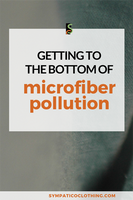Getting to the bottom of microfiber pollution
Posted by Rose on 10th May 2022
Why choosing eco-friendly, sustainable clothes is more important than ever.
Patagonia, the outdoor apparel maker, along with other industry partners have commissioned a study to better understand how microfiber pollution happens. These tiny plastic particles are shed every time petrochemical derived textiles are laundered. While many people associate plastic pollution with plastic bottles and shopping bags, in reality, somewhere between 70 - 90 percent of the plastic fibers that are polluting our oceans come from textiles. I blogged about this problem last spring.
Patagonia and other outdoor manufacturers and retailers have underwritten research by The Ocean Wise Plastics Lab. The lab has been investigating microplastic particles in the water and animals of the Pacific and Arctic oceans since 2014. The new mission was to identify more precisely the sources of microparticle pollution and potential science-based fixes.
Ocean Wise’s Plastics Lab studied a variety of outdoor apparel fabrics provided by their sponsoring partners. The amount of microfibers shed by each fabric during laundering was meticulously tracked using an elaborate filtration system. The lab also studied how these synthetic textiles weather and break down when exposed to the environment. Data gathered through both of these experiments have helped Ocean Wise develop a library of microscopic textile particles that can be used to pinpoint specific pollution sources. Their studiens demonstrate that:
Between 31,000 and 3,500,000 fibers are shed per wash load
Fleeces and brushed fabrics are the worst shedders
Some fabrics shed a lot at first, but little later, suggesting a factory pretreatment may help
The ongoing effort will look more deeply at how microfibers impact sea life. You can explore the Ocean Wise website to find out more. Their chart (below) for consumers offers four simple ways to minimize your own microfiber pollution.
Infographic provided by Ocean Wise/Vancouver Aquarium.
Because the wicking properties and light weight of synthetic, technical clothing fibers are so valuable for extreme weather and severe uses, I understand why Patagonia and its partners are committed to using them. So I applaud their efforts in trying to understand and mitigate the problems these fibers cause in our oceans.
Thankfully though, most Sympatico customers don’t face those ultra-demanding conditions in their everyday wear. That’s why I love the fact I can work with a natural fiber like hemp. Blended with sustainably grown and manufactured Tencel, it offers excellent wearability without threatening the world’s water supply.
The hemp content in Sympatico’s eco-friendly clothes is naturally antimicrobial. You’ll likely find yourself laundering your clothes less because they’ll pass the sniff test longer. Studies show the energy used to wash apparel is greater than the energy consumed making it. So on top of helping to minimize microfiber pollution, you’re also reducing the energy used in laundering.
Sympatico’s lineup of tops, skirts, and pants are sustainably crafted in the USA.
More: Down the drain: Microfiber pollution hidden threat

Share:






